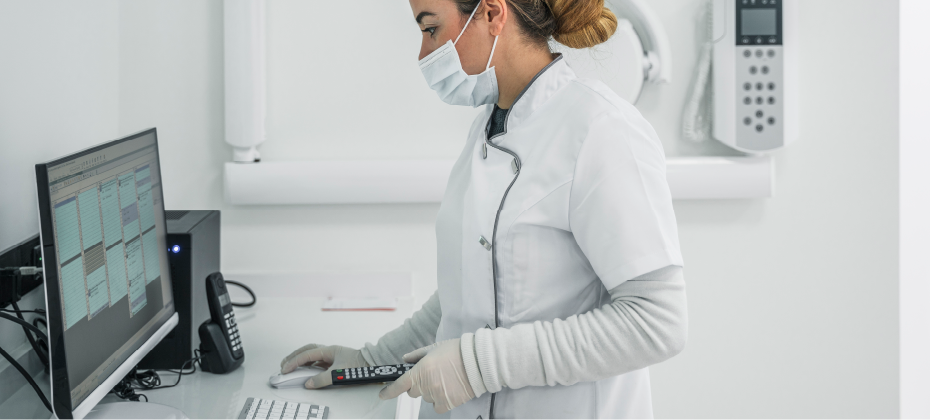All posts by Experian Health

Many patients today are forced to call the doctor to schedule an appointment. These phone calls are often inconvenient: patients are required to call during a provider’s business hours, a single call can sometimes take up to 20 minutes, or the patient may end up playing phone tag until an appointment is finally booked. The entire process bodes for a poor patient experience, but also hinders access to care as staff are only able to manage a number of phone calls per day. Like many healthcare organizations today, The Iowa Clinic wanted to improve access to care for its patients, removing the many barriers that come with having to call to schedule an appointment. Requiring a solution that could both improve patient satisfaction and operational efficiencies, the clinic, which schedules more than 600,000 appointments per year across multiple specialties, turned to online self-scheduling. With online self-scheduling, patients of The Iowa Clinic have the ability to self-schedule directly into provider’s calendars in real time from a computer or mobile device. During the booking process, patients are asked a series of brief questions and their answers are used to guide them to the right provider and appointment based on their specific care need. Appointments can be booked any time of day or night. Since implementing online self-scheduling, The Iowa Clinic has not only improved access for patients, but has enhanced operations throughout the call center, seen growth in patient acquisition and has achieved higher than average show rates. Results include: At least 15% of all appointments booked came from online during the first eight monthsThe centralized call center has seen a 30% reduction in the number of scheduling callsAt least 8 new patient appointments are booked online per provider per month Patient show rates are at 97% for appointments scheduled online Learn more about online self-scheduling and how it can help to improve patient access for your organization. “Patient Schedule allows us to improve the experience by offering a simple, convenient way to schedule an appointment online.”- C. Edward Brown, CEO, The Iowa Clinic

With a vaccine for COVID-19 thought to be at least a year away, healthcare providers are steeling themselves for even more cases in the fall. The big worry is that a surge in cases will hit the health system just as flu season takes hold. In a recent interview, Dr. Robert Redfield, Director of the Centers for Disease Control and Prevention (CDC), warned that “the assault of the virus on our nation next winter [may] actually be even more difficult than the one we just went through… we’re going to have the flu epidemic and the coronavirus epidemic at the same time.” Healthcare organizations are accustomed to an influx of sick patients between October and March: around 62,000 people died and more than 700,000 were hospitalized during last winter’s flu season. With 130,000 Americans losing their lives to COVID-19 in just four months, what could happen when the two respiratory diseases collide? Large numbers of patients with either virus (or potentially with both) will put renewed pressure on staff and services that are already under immense strain. Hospitals will need to prepare to manage both groups of patients as efficiently and safely as possible. Five ways to ease stress, paperwork and patient concerns ahead of a dual epidemic 1. Use data to drive your patient engagement strategy Create a flu preparedness patient engagement strategy to keep patients informed of how best to protect themselves in the context of a dual epidemic. As a result of the coronavirus pandemic, patients may be more familiar with telehealth services as a “contact-free” alternative to in-person appointments, so you’ll want to continue to promote these to minimize the spread of infection. With consumer data, you can segment patients according to risk and automate your communications, so they get the most relevant message at the most convenient time. 2. Relieve pressure on staff with automated patient scheduling Digital scheduling gives patients the option to book appointments online, at a time and place that suits them. This reduces pressure on call center staff and can give providers control over the volume and timing of in-person appointments, thus helping to reduce the spread of germs. An online patient scheduling platform can automate the entire scheduling process, integrating in real-time with your records management systems and connecting to your referral providers’ systems for a seamless patient and staff experience. 3. Screen patients proactively to discover their needs ahead of time Asking patients to fill out electronic questionnaires before their visit means their access needs can be identified and addressed before they come in. Do they need help to find transportation? Will they face any challenges in picking up a prescription? Is there something that could stand in the way of follow-up care? Screening for social determinants of health can answer these questions so you can direct patients to the most appropriate care and support. 4. Enable digital patient registration for a quick and easy intake experience Speed up the registration process by giving patients the option to complete their intake admin by phone or through their patient portal. Not only will this reduce the spread of infection in busy waiting rooms, it’ll make for a more enjoyable patient experience and free up limited staff resources for other priorities. With automated registration and consumer-facing mobile experiences, you can improve the patient experience, operational efficiencies and data accuracy all at the same time. 5. Minimize in-person interactions with contactless payments Encourage patients to clear their balances without having to hand over cash or access payment kiosks. Self-service digital payment tools allow patients to make contactless payments through their patient portal or from their mobile device. “The combined pressure from two viruses hitting health systems at once means it’s even more important for providers to leverage data for speed and accuracy. Automated workflows can help accelerate operational efficiency, as well as create a better patient experience during what’s already an extremely stressful time.” Victoria Dames, Vice President of Product Management for Experian Health Find out more about how Experian Health’s expertise in data and analytics can help your organization prepare for the coming flu season so you can offer your patients a safe, accessible and stress-free experience. We have also developed a checklist of action items for providers to consider as you prepare for both flu and COVID-19. How ready are you? Which actions is your organization instituting now?

By January 2021, millions of those who suffered job losses in the wake of COVID-19 will see their unemployment insurance end. Medicaid and subsidized coverage under the Affordable Care Act (ACA) will be a safety net for many, but nearly 2 million Americans could find themselves stuck in the ‘coverage gap’, where their household income exceeds the eligibility threshold for Medicaid, yet falls below the lower limit required to receive ACA marketplace subsidies. Without large group or government coverage, these consumers will be left uninsured or forced to purchase individual plans with high deductibles. Considering this will likely contribute to larger patient balances and more struggles with patient collections, many are bracing for a hit to their bottom line. To help minimize accounts receivable and avoid bad debt write-offs, choosing the right data model should be a top priority. Here, we look at one piece that’s often missing from the patient collections puzzle: credit data. Don’t overlook credit data in your self-pay collections strategy Many providers already use demographic and behavioral data to power patient collections, but there can be gaps in what’s known about a consumer’s ability to pay. Credit data can help fill in the blanks. Here are three ways this can be used to optimize your collections strategy: 1. Get a complete view of your patients’ financial situation for faster decision-making Credit data can reveal how a patient is managing other financial obligations, giving you insights about how to handle their healthcare account for a greater chance of payment. Have they just maxed out a credit card? Have they missed a student loan payment or fallen behind on their mortgage? If so, they’re probably going to find it difficult to pay off their medical bill. Knowing this, you can move quickly to help them find alternative coverage or offer a more manageable payment plan. Conversely, if they’ve just bought a new car or paid off a personal loan, there’s a high chance they’re in a good position to pay their medical bills too, so contacting them with a straightforward and easy payment plan means they can clear their balance promptly. 2. Segment patient accounts and allocate them to the right payment pathway The sooner you can get patients onto the right payment pathway, the more robust your cashflow will be. Credit data can help you segment accounts quickly and accurately. Experian Health data shows that when patients are segmented according to propensity to pay, collections increase by around 2% when credit data is included, compared to segmentation without credit data. Novant Health used Collections Optimization Manager to segment patients and check for available charity support or Medicaid eligibility. By getting patients on the right pathway and making sure agencies were focusing on the right accounts, they increased recovery rates by 5% and saw a rolling average return on investment of 8.5:1. 3. Create a more compassionate patient financial experience Using credit data also helps create a more compassionate patient financial experience. Instead of adding to a patient’s financial worries by chasing payments they’ll never be able to cover, you can run charity checks to see if there’s any missed coverage and quickly connect them to the right financial assistance program. A tool such as Collections Optimization Manager lets you segment patients based on their individual circumstances, for a more patient-friendly approach to collections. You can then personalize their communications and payment options so they can manage their expenses with less anxiety and more confidence. Discover why 60% of US hospitals are already using Experian Health’s advanced collections software and unrivaled datasets to optimize patient collections, and find out how we can help you build a resilient revenue cycle as self-pay accounts continue to rise.

For many healthcare consumers, visiting patient portals to check medical records, schedule appointments, renew prescriptions and pay bills is a no-brainer. Accessible from multiple devices at any time of day, patient portals allow patients to manage their health from the comfort and convenience of their own home. COVID-19 has been a catalyst for even more patients to consider remote and virtual healthcare services. But with large healthcare data breaches increasing by nearly 200% between 2018 and 2019, one concern continues to lurk in the background: how do providers keep patient data safe? Knowing the industry is prone to dated cybersecurity measures, hackers zero in on the lucrative medical identities market, with their top targets including: patient medical records billing information log-in credentials authentication credentials, and clinical trial information. As COVID-19 encourages more patients online, the digital doors are open for even more identity thieves to try to steal – and profit from – sensitive data. Healthcare organizations need to be confident that the person logging on is who they say they are, both to reduce the risk of a data breach and minimize HIPAA penalties. One way to balance consumer convenience with data security is to automate the patient portal enrollment process with robust patient identification protocols, making it harder for hackers to access patient information but without burdening patients. 2 ways to automate patient portal enrollment 1. Ditch activation codes that are easily misplaced Many healthcare organizations give new patients an activation code to use the first time they log in to their patient portal. Unfortunately, these tiny bits of paper or codes hidden at the bottom of lengthy enrollment documents are easily lost or forgotten. The patient has to call the office, taking up valuable staff time and resources to figure out how to log on – the opposite of streamlined and scalable. Instead, providers should consider an automated portal sign-up process. Using a combination of out-of-wallet questions, device recognition, risk models and cross-checks with linked patient data, portal access can be secured through a single platform. It’s easier and more reassuring for patients, and with far fewer calls to IT support. 2. Find quicker ways to integrate patient identity tools with existing systems The more people who need to see patient data, the more opportunities there are for cyber thieves to sneak in and access that sensitive information. Being able to share data securely between multiple providers and across different platforms is essential. During the current COVID-19 crisis, integrating authentication tools with other healthcare information systems (HIS) quickly is a huge advantage. One example is Precise ID, which can now integrate directly with Epic’s MyChart portal, Allscripts’ FollowMyHealth platform and many other HIS systems within two weeks. Jason Considine, senior vice president and general manager of Experian Health’s Patient Experience Solutions says: “Patients want to feel reassured that their data won’t wind up in the wrong hands. That’s even more important right now, as COVID-19 means more patients are choosing online services instead of face-to-face contact. With staff and cashflow under pressure, it’s even more important to get systems up and running as fast as possible. That’s why we’ve integrated with leading HIS systems to help them achieve interoperability within just two weeks.” Patient portals have the power to transform the healthcare experience for patients, but only if they can trust that their data will be kept safe. Providers can protect their patients from identity theft by adopting a multi-layered solution that incorporates best practice and cutting-edge data security technologies. Find out more about how Experian Health can help you automate patient portal security to avoid medical identity theft, so you can save money, avoid reputational damage and create a positive patient experience.

Medical expenses are often a source of anxiety for many patients, whether they are unsure about the amount owed or how they’ll ultimately pay for it. Unfortunately, intimidating collections processes don’t help, and a crisis like COVID-19 only exacerbates this stress. A more compassionate billing approach could help patients better navigate their financial obligations and also build long-term loyalty—a necessity for providers today looking to retain patient volume during a time of crisis. Consumers overwhelmingly want to understand the cost of healthcare services, prior to services being performed. Effective price transparency involves offering patients clear, accessible, and easy-to-understand estimates of their financial responsibility for services before they are performed. Give patients clarity from the start with precise pricing estimates and up-front info about what they’ll have to pay can reduce sticker shock, help them plan and create an overall better patient financial experience. By empowering your patients with financial expectations, their feeling of control increases, improving their engagement and the likelihood that you will collect payments faster and more efficiently. Just as you don’t provide identical medical treatment to every patient, processing all patient accounts the same way doesn’t make sense. Every patient is different. Using comprehensive data and advanced analytics, providers can better understand an individual's propensity to pay and make the payment process a positive one by assessing and assigning each patient to the appropriate financial pathway based on their unique financial situation. Medical bills are often the most direct contact providers have with patients after a service is rendered. Unfortunately, money is often a sensitive topic for patients and statements are often overwhelming and difficult for patients to read. Tailoring communications at each stage can convey compassion and increase patient satisfaction. Customizing patient statements gives providers the ability to simplify and customize bills quickly and easily, turning an often confusing process into one that adds value. Including relevant, personalized messages and educational updates can turn billing statements into a useful resource, all with the potential to drive revenue. In addition to offering personalized payment options, providers can also find out whether a patient prefers to discuss billing by phone or email. Minimizing friction at the point of payment is crucial to fostering compassionate collections. Providers should offer flexible options that include in-person, telephone, mobile and online patient portals, so they can pay in a way that’s most convenient for them. This also frees up staff to help those patients who may need a little extra help understanding their statement. Want to learn more? Check out Experian Health’s Collections Optimization Manager which helps providers segment patients based on an individual’s propensity to pay and payment preferences, informing a compassionate patient engagement strategy and improving collections.

With COVID-19 leading to postponed and cancelled medical appointments, more consumers are turning to “contactless care”. Recent figures suggest telehealth adoption has shot up from just 11% in 2019 to 46% over the course of the pandemic, and some providers are seeing up to 175 times the number of telehealth patients than pre-COVID. As they grapple with the surge in patient volumes alongside regulatory change, many are playing catch-up. For patients, rushed implementation means the telehealth experience can fall short of expectations. Compared to the easy one-click services available with online retail and finance platforms, telehealth can feel clunky and frustrating. Technical issues, not knowing how to prepare for appointments, and a lack of awareness of available services can all taint the consumer experience. Providers looking to launch (or re-launch) a patient-friendly telehealth service ahead of a possible second wave should aim to check off these four considerations before rolling it out. 1. Prioritize easy online scheduling for virtual care Allowing patients to book telehealth appointments when it suits them will help to reduce no-shows and minimize delays. A telehealth platform that integrates with physician calendars and other patient management and record management systems will keep things running smoothly at the operational level, while creating a convenient and secure way for patients to schedule care. For example, when Benefis Health System implemented Patient Schedule, more than 50% of patients chose to book their appointments out of normal working hours. Sam Martin, digital developer and web specialist at Benefis, says: “If you’re not allowing your patients to schedule online, you’re behind the times. You can only benefit from it. We’re seeing the number of online bookings continue to grow every month, confirming that this solution is working for patients.” 2. Include quick and reliable coverage checks With the pandemic and resulting unemployment putting both provider and patient cashflow under strain, any available commercial or government coverage must be identified quickly. Providers should run automated coverage checks to find any missing coverage and select the right financial pathway for each patient as soon as possible. Not only will this create a more compassionate patient financial experience, it’ll allow the collections team to focus their attention on the right accounts and minimize the risk of write-offs. Automated Coverage Discovery screens for eligibility through Medicare, Medicaid or commercial plans, without any collections agency getting involved. With this tool, Essentia Health were able to find coverage for 16,990 accounts that were assumed to be self-pay or uninsured. Kathryn Wrazidlo, Patient Access Director, says: “This has helped patients because we’re actually billing their insurance versus billing them for self-pay. It’s helping staff because they’re billing the insurance company much quicker. There’s less rework.” 3. Get telehealth claims right first time Given that the pandemic may cost hospitals an estimated $200 billion between March and June 2020, there’s no room for the added financial burden of claim denials. But as telemedicine expands, so does its regulatory framework. Providers must keep track of changing payer updates and coding rules so that claims are submitted right first time. An automated, data-driven claims management tool can help providers analyze claims with greater confidence and spot any errors well in advance of submission. Telehealth alerts can be included as customized edits, to confirm whether the patient’s current plan includes virtual care. To help providers manage this process, Experian Health is offering free access to telehealth payer policy alerts through our COVID-19 resource center. 4. Protect patient data As with any part of the digital patient experience, a multi-layered approach to protecting sensitive information is a must. Ideally, this will include two-factor patient identity authentication, device recognition and out-of-wallet checks whenever a log-in attempt looks suspicious. Automating this process with a tool such as Precise ID allows providers to integrate multiple data points to check that a patient is who they say they are, in a way that’s HIPAA-compliant. This makes it harder for thieves to access patient data, without burdening the patient with extra checks as they manage their information. Retaining patient volume and rebuilding revenue through “contactless” care won’t be possible unless the entire telehealth journey is as seamless as possible. From scheduling to payment, Experian Health can help you create a virtual patient experience that’s convenient, secure and reliable. To learn more about how to build a better digital patient journey, download our free eBook.

Consumers today expect fast and convenient access to almost everything, healthcare included. While still only offered by a fraction of healthcare providers out there, online scheduling is catching on throughout the market – especially as more providers turn to telehealth solutions during COVID-19. Still, despite the uptick in online self-scheduling, there are patients who prefer to call to schedule an appointment and call centers may be overwhelmed as a large number of patients rush to reschedule appointments that were cancelled or postponed due to COVID-19. To best prepare, providers will want to ensure the best possible patient experience for those calling to schedule an appointment. This can be done by enabling online scheduling throughout the call center. Here are five ways to make patient scheduling easy through your call center: Save timeWith a manual scheduling process, patients often have to sit on the phone – sometimes for upwards of twenty minutes – while also being put on hold or having to wait to be called back to confirm an appointment. It’s not only an awful patient experience but imagine what all that time adds up with the number of scheduling calls providers receive every single day? By reducing call times you’re making the process more efficient for more routine scheduling calls while also opening up call center agents to focus on those patients who need more attention. Automate the rulesThe key to reducing time spent scheduling an appointment is automating the scheduling protocols and business rules of the providers in the scheduling platform. Call center agents traditionally have to manually navigate expansive spreadsheets or three-ring binders of business rules with the scheduling criteria for each provider. Experian automates all those rules in our system and translates them to easy Q&A prompts for the scheduler while on the phone with a patient. In short, rules automation equals quicker scheduling (while maintaining accuracy). Improve trainingBecause the rules are automated, the training process for call center agents is made much more efficient. Where agents would have had to learn the various nuances of scheduling complex specialty care for a variety of providers, they now just need to learn how to use the scheduling platform. The scheduling protocols are automated and help dialogues will pop-up to explain and guide agents through the scheduling process for every provider and care type. Where it may have taken 60 to 90 days to master scheduling for a new specialty, schedulers can now be experts for that specialty in as little as one hour. IntegrationIn order to get the most out of any scheduling solution it needs to integrate into the provider’s practice management system. Leveraging APIs or HL7 bi-directional connectivity, all bookings occur in real-time. This prevents any double-bookings and also removes any calendar maintenance by staff to block and recheck time for providers. With the integration, bookings from the call center transact the same as if a staff member was logged in at the providers office and scheduling on the spot. Automated outreachProviders can use automated outreach to augment their call center capabilities. With it they can send text message and IVR campaigns to patients with the ability for patients to schedule an appointment in real-time on the phone. Check out Patient Schedule to learn more or download our free guide about how scheduling can be made easier for your patients through all of your access channels.

Patients today expect digital capabilities from their provider and will increasingly choose those who offer digital capabilities. Knowing this, many providers have been working to shift more of the patient journey online, through telehealth and virtual care. Not all care needs to be delivered face to face, and technological advances allow patients to access more services from the comfort of their own homes, at a time that suits them. This trend has been visible for a few years now, as consumers sought out more smartphone-friendly digital healthcare experiences. But change in the healthcare industry often comes at a lumbering pace, so when the coronavirus pandemic hit and accelerated the transition to remote care, many organizations found themselves on the back foot. Now, it’s a case of catch-up, keep up or get left behind. As demand for telehealth services grows, so too does the regulatory framework around it. A big part of staying competitive will be the ability to keep track of new telehealth regulations and changing payer rules. Those that don’t will find their collections straining under the added pressure of missed reimbursement opportunities. How can providers stay on top of the changes and maximize reimbursement? Keeping track of telehealth reimbursement regulations Since early March 2020, the federal government has moved to make telehealth more accessible to patients with Medicare coverage. Limitations on the types of clinicians that can provide telehealth services under Medicare have been waived, while Medicare beneficiaries in rural areas and those with audio-only phones can now access care remotely. New telehealth services will be added to the reimbursable list under a quicker process, which is a huge benefit to both patients and providers, but will mean the rules around reimbursement could change more frequently. Speaking in March, CMS Administrator Seema Verma said: “These changes allow seniors to communicate with their doctors without having to travel to a healthcare facility so that they can limit risk of exposure and spread of this virus. Clinicians on the frontlines will now have greater flexibility to safely treat our beneficiaries.” Flexibility is always welcome – but what do looser rules mean for reimbursement workflows? Three challenges stand out: Payer variation. Telehealth and telemedicine data can be presented differently by different payers, causing a headache for providers during eligibility verification.Coding variation. Each type of telehealth visit is coded and billed differently. Regardless of where appointments are carried out, clinicians must still follow the same billing workflow, so keeping track of the differences is essential.Geographical variation. Providers now have to track billing and coding changes for telehealth services from different payers across multiple states. What can providers do to bill telehealth services as accurately as possible? Billing for telehealth services more frequently calls for a solution that’s flexible enough to keep pace with changing payer rules, and sufficiently scalable to provide real-time reimbursement information when it’s needed. Automation can help achieve both of these goals. Two use cases for automation: Quicker Medicare checks: Run quick and accurate checks to confirm patients are eligible for Medicare coverage for the services in question. A tool such as Coverage Discovery can comb for available coverage, even as patients are switching plans or payer rules are changing. In addition, eligibility verification automations can sweep for coverage information on telehealth services, using reliable and secure third-party data and analytics to check for updates. Cleaner claims submissions: Tighten up billing workflows so that claims can be submitted as soon as possible. Claims management software can run automatic checks so that every claim is submitted clean and error-free. Any missing or incorrect codes can be flagged up, eliminating costly and time-consuming rework. Telehealth alerts can be included as customized edits to confirm whether virtual care is a benefit included in the patient’s current plan. While these actions can help protect your bottom line during the immediate crisis, they’ll also help you build a solid foundation as your telehealth offering inevitably continues to grow. Whether you’re looking to verify coverage, check eligibility or protect patient identities as they log in and use telehealth services, reliable data is key. Schedule a free consultation to discover how Experian Health can help you leverage accurate and real-time data insights to optimize your billing workflow and maximize telehealth reimbursements.

At the beginning of the year, the healthcare industry moved away from Medicare identifiers based on Social Security Numbers (SSNs), in favor of more secure Medicare Beneficiary Identifiers (MBIs). As with any large-scale change program, the shift was unlikely to be completely clear sailing. But with the coronavirus pandemic landing shortly after the 21-month transition period was due to conclude, the switchover has been rougher than expected. Impacted Care Care providers are discovering newly eligible Medicare beneficiaries who haven’t yet received their card, while existing beneficiaries have misplaced theirs. Without a valid MBI number, patients risk delayed access to care, while the admin process to sort it out can be stressful, especially for already-vulnerable senior populations. For providers, the extra work and delayed reimbursements are particularly unwelcome when COVID-19 is already putting pressure on services and squeezing revenue. Unprecedented intake conditions where staff and patients are trying to limit face-to-face contact makes it difficult to complete the usual coverage checks. As a result, providers are missing revenue opportunities they cannot afford, while incurring additional downstream costs when collections are delayed. Experian Health clients are optimizing Coverage Discovery to speed things up. Case study: how one healthcare provider is finding missing Medicare coverage faster For example, the southeast division of a national health care system, with 1700+ beds and $1.6B in revenue, needed better ways to find MBIs when Health Insurance Claim Numbers (HICNs) were phased out. Assisting Medicare patients with tracking down their MBIs was time-consuming and error-prone. They came to Experian Health to find a more efficient way to check Medicare coverage. Jason Considine, Experian Health’s Senior Vice President for Patient Collections and Engagement, says: “We knew we could help because we already had Medicare coverage history through our historical repository. As a test, we were given a control set of known Medicare patients without MBIs, and were charged with finding those patients’ MBIs and Medicare coverage.” Experian Health’s Coverage Discovery tool was used to batch-process the control set. This took less than a day, as the tool scans more than one million accounts daily, using historical and demographic data, synthesized with multiple proprietary data sources, to find unknown or forgotten coverage. In this case, the resulting data was collated via batch files, but could be integrated with other coverage and collections tools, such as eCareNext, which automates the more repetitive and hands-on pre-registration tasks. Coverage Discovery found 60% of the Medicare coverages with MBIs, plus additional coverages. This enabled the provider to file claims that would otherwise have been nearly impossible and very time consuming. The provider’s next steps will be to integrate Coverage Discovery with eCareNext, and roll it out to more of sites in the system. Could Coverage Discovery help your organization find missing MBIs? Capturing better insights into productivity, financial results, and staff workflows is always valuable. But in the current crisis, tool that maximize reimbursement and automating the tasks that take up staff time is essential. Through our historical data repository, Experian Health’s Coverage Discovery already contains many patient MBIs – and it’s continually updated. We can help you search for Medicare coverage and make sure your clients find their MBIs, easing pressure off your revenue cycle management teams during this extremely challenging time. Request a review of Coverage Discovery and improve your coverage and collections processes.
